driver seat adjustment FORD EXPLORER 2013 5.G Owners Manual
[x] Cancel search | Manufacturer: FORD, Model Year: 2013, Model line: EXPLORER, Model: FORD EXPLORER 2013 5.GPages: 576, PDF Size: 6.87 MB
Page 1 of 576
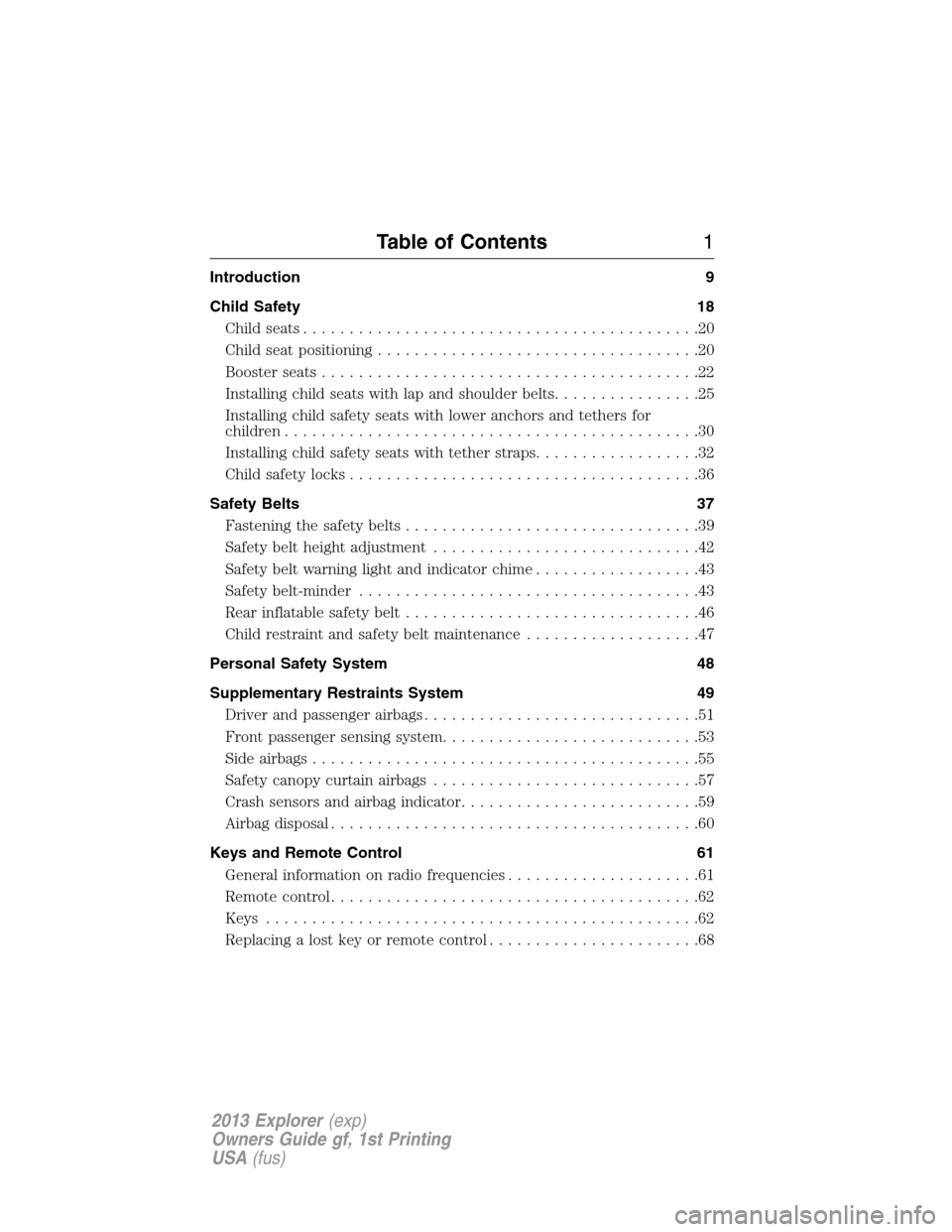
Introduction 9
Child Safety 18
Child seats...........................................20
Child seat positioning...................................20
Booster seats.........................................22
Installing child seats with lap and shoulder belts................25
Installing child safety seats with lower anchors and tethers for
children.............................................30
Installing child safety seats with tether straps..................32
Child safety locks......................................36
Safety Belts 37
Fastening the safety belts................................39
Safety belt height adjustment.............................42
Safetybeltwarninglightandindicatorchime..................43
Safety belt-minder.....................................43
Rear inflatable safety belt................................46
Child restraint and safety belt maintenance...................47
Personal Safety System 48
Supplementary Restraints System 49
Driver and passenger airbags..............................51
Front passenger sensing system............................53
Side airbags..........................................55
Safety canopy curtain airbags.............................57
Crash sensors and airbag indicator..........................59
Airbag disposal........................................60
Keys and Remote Control 61
General information on radio frequencies.....................61
Remote control........................................62
Keys...............................................62
Replacing a lost key or remote control.......................68
Table of Contents1
2013 Explorer(exp)
Owners Guide gf, 1st Printing
USA(fus)
Page 40 of 576
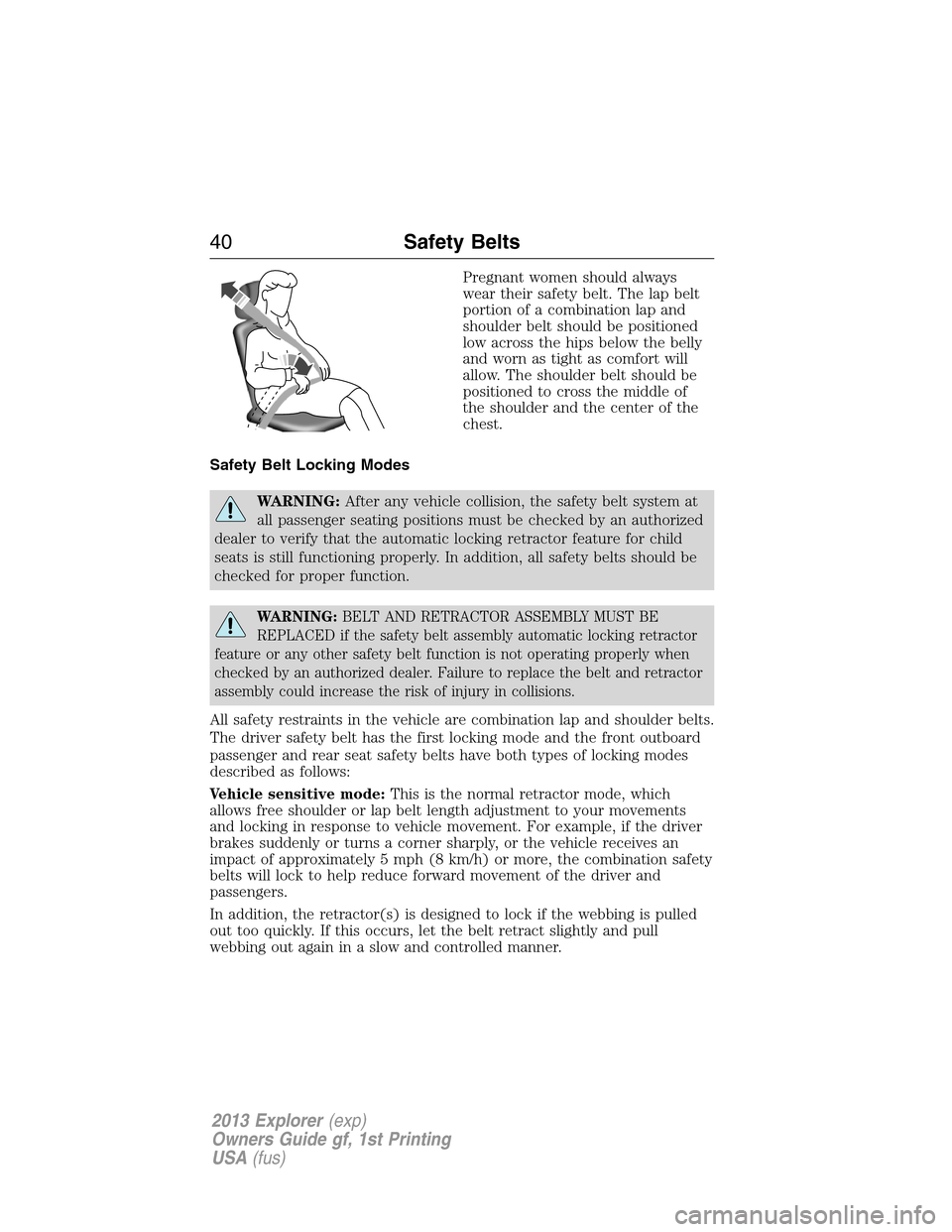
Pregnant women should always
wear their safety belt. The lap belt
portion of a combination lap and
shoulder belt should be positioned
low across the hips below the belly
and worn as tight as comfort will
allow. The shoulder belt should be
positioned to cross the middle of
the shoulder and the center of the
chest.
Safety Belt Locking Modes
WARNING:After any vehicle collision, the safety belt system at
all passenger seating positions must be checked by an authorized
dealer to verify that the automatic locking retractor feature for child
seats is still functioning properly. In addition, all safety belts should be
checked for proper function.
WARNING:BELT AND RETRACTOR ASSEMBLY MUST BE
REPLACED if the safety belt assembly automatic locking retractor
feature or any other safety belt function is not operating properly when
checked by an authorized dealer. Failure to replace the belt and retractor
assembly could increase the risk of injury in collisions.
All safety restraints in the vehicle are combination lap and shoulder belts.
The driver safety belt has the first locking mode and the front outboard
passenger and rear seat safety belts have both types of locking modes
described as follows:
Vehicle sensitive mode:This is the normal retractor mode, which
allows free shoulder or lap belt length adjustment to your movements
and locking in response to vehicle movement. For example, if the driver
brakes suddenly or turns a corner sharply, or the vehicle receives an
impact of approximately 5 mph (8 km/h) or more, the combination safety
belts will lock to help reduce forward movement of the driver and
passengers.
In addition, the retractor(s) is designed to lock if the webbing is pulled
out too quickly. If this occurs, let the belt retract slightly and pull
webbing out again in a slow and controlled manner.
40Safety Belts
2013 Explorer(exp)
Owners Guide gf, 1st Printing
USA(fus)
Page 51 of 576
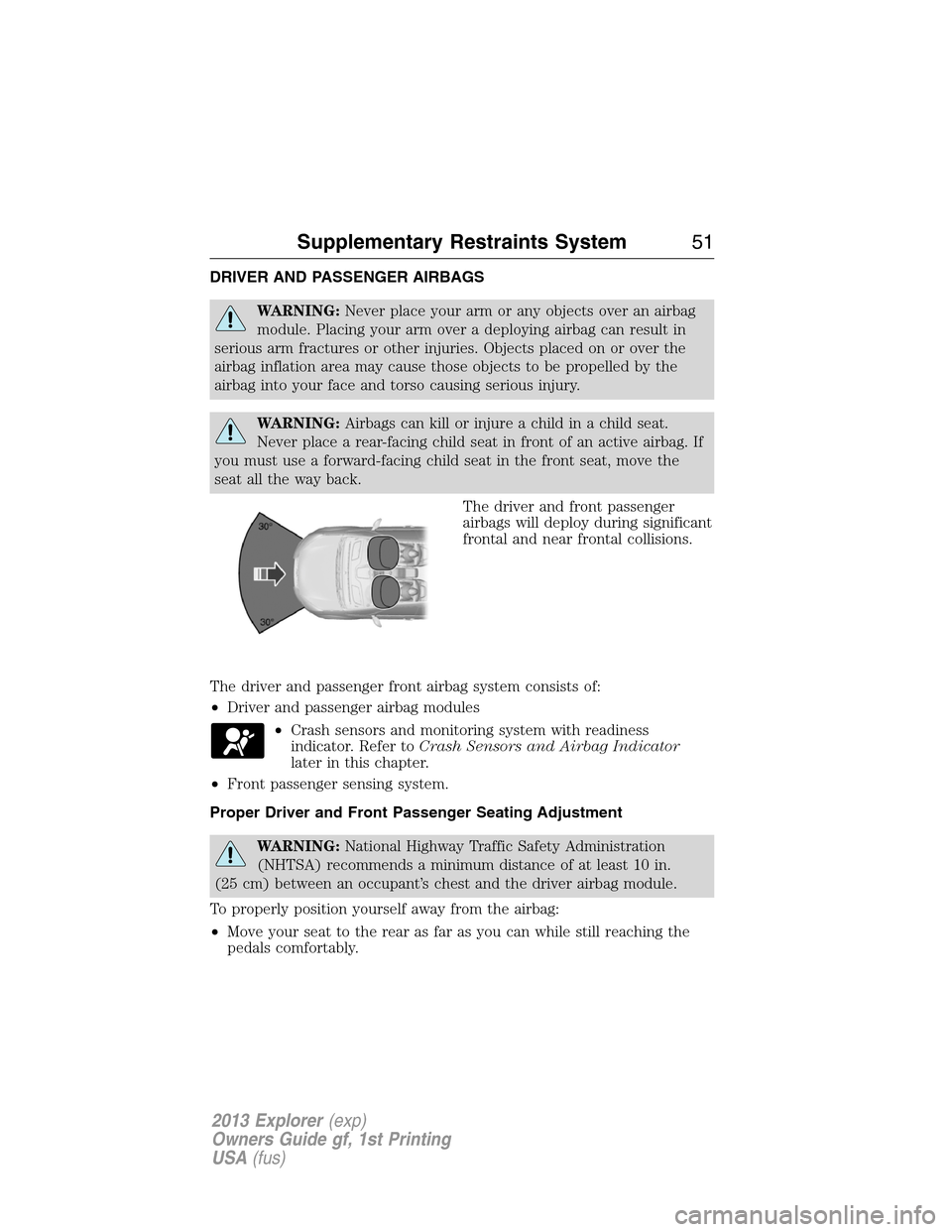
DRIVER AND PASSENGER AIRBAGS
WARNING:Never place your arm or any objects over an airbag
module. Placing your arm over a deploying airbag can result in
serious arm fractures or other injuries. Objects placed on or over the
airbag inflation area may cause those objects to be propelled by the
airbag into your face and torso causing serious injury.
WARNING:Airbags can kill or injure a child in a child seat.
Never place a rear-facing child seat in front of an active airbag. If
you must use a forward-facing child seat in the front seat, move the
seat all the way back.
The driver and front passenger
airbags will deploy during significant
frontal and near frontal collisions.
The driver and passenger front airbag system consists of:
•Driver and passenger airbag modules
•Crash sensors and monitoring system with readiness
indicator. Refer toCrash Sensors and Airbag Indicator
later in this chapter.
•Front passenger sensing system.
Proper Driver and Front Passenger Seating Adjustment
WARNING:National Highway Traffic Safety Administration
(NHTSA) recommends a minimum distance of at least 10 in.
(25 cm) between an occupant’s chest and the driver airbag module.
To properly position yourself away from the airbag:
•Move your seat to the rear as far as you can while still reaching the
pedals comfortably.
Supplementary Restraints System51
2013 Explorer(exp)
Owners Guide gf, 1st Printing
USA(fus)
Page 172 of 576
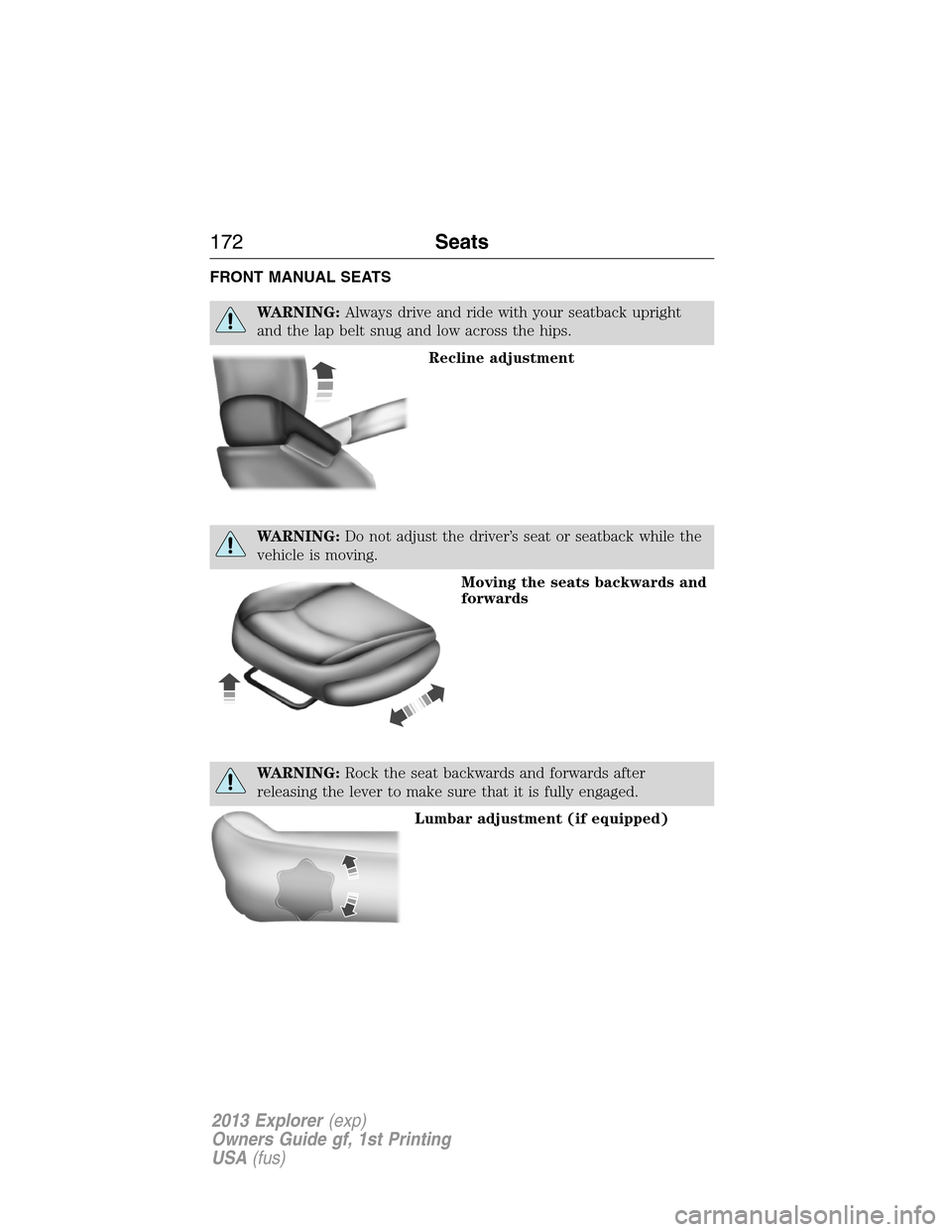
FRONT MANUAL SEATS
WARNING:Always drive and ride with your seatback upright
and the lap belt snug and low across the hips.
Recline adjustment
WARNING:Do not adjust the driver’s seat or seatback while the
vehicle is moving.
Moving the seats backwards and
forwards
WARNING:Rock the seat backwards and forwards after
releasing the lever to make sure that it is fully engaged.
Lumbar adjustment (if equipped)
172Seats
2013 Explorer(exp)
Owners Guide gf, 1st Printing
USA(fus)
Page 173 of 576
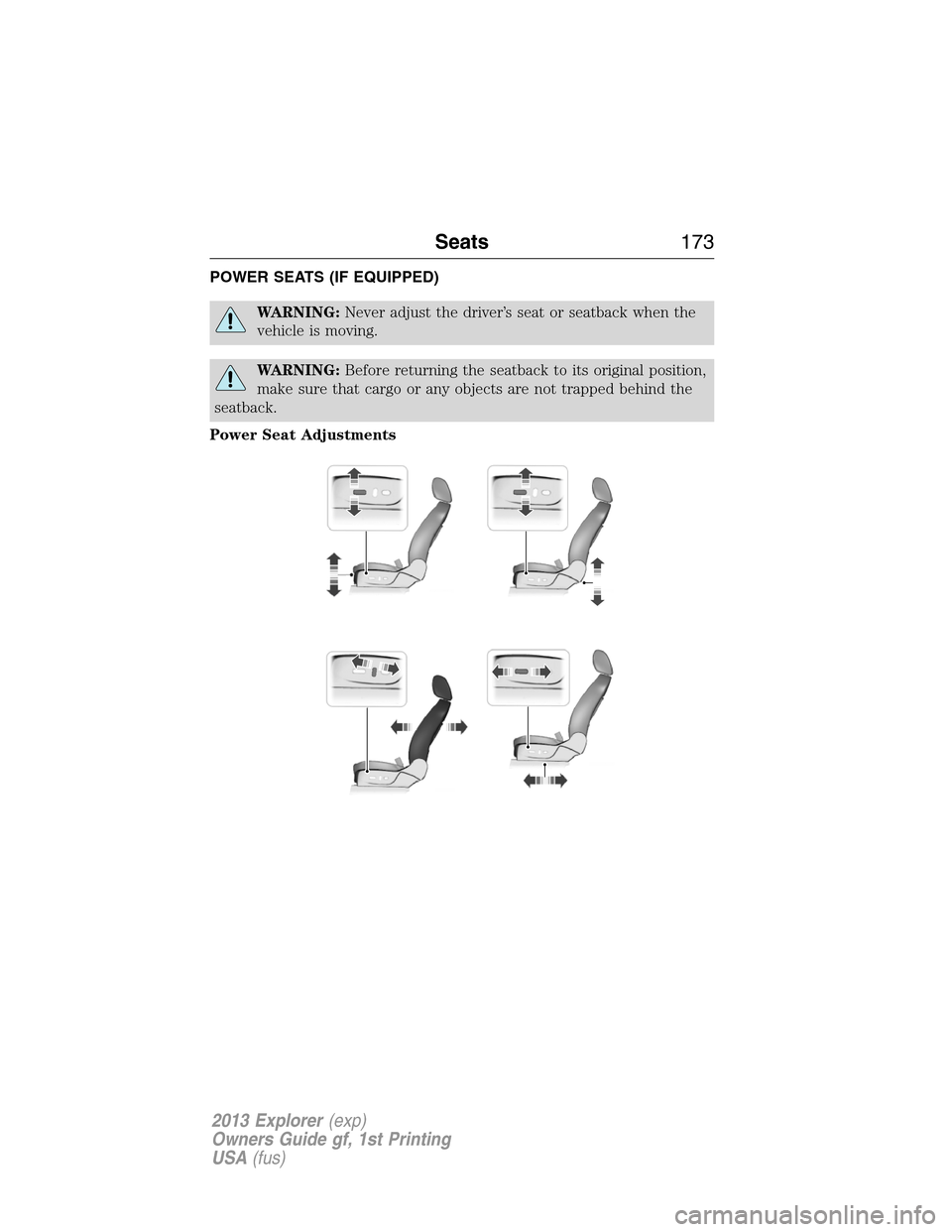
POWER SEATS (IF EQUIPPED)
WARNING:Never adjust the driver’s seat or seatback when the
vehicle is moving.
WARNING:Before returning the seatback to its original position,
make sure that cargo or any objects are not trapped behind the
seatback.
Power Seat Adjustments
Seats173
2013 Explorer(exp)
Owners Guide gf, 1st Printing
USA(fus)